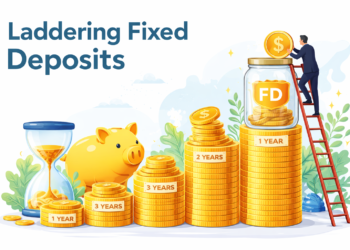The slow and steady rise in the average cost of goods and services over time is known as inflation, and it has the exclusive power to influence interest rate trends and, in turn, savings returns. A significant factor that decides how savings improve over time is the savings account interest rates that banks, credit unions and other financial organisations provide. However, the relationship between interest rates and inflation creates a complicated dynamic that can increase or decrease the actual value of savings.
Relation between inflation and interest rates
It is clear from the complex relationship between these factors that monetary policy is essential to controlling inflation and preserving general economic stability. Examining how changes in interest rates might affect inflation and vice versa is necessary to comprehend this relationship.
To calculate the savings account interest rate during inflation, one can use the formula of real interest rate. The real interest rate is adjusted for inflation, providing a more accurate reflection of the correct cost of borrowing or the real return on investment.
The formula is real interest rate = nominal interest rate – inflation rate. For example, if the nominal interest rate is 6% and the inflation rate is 2%, the real interest rate = 6-2 = 4.
The real interest rate would be 4% and banks would pay interest based on the real interest rate calculated.
Impact of inflation on savings account interest rates
Interest rates and inflation have an intense relationship. Central banks frequently raise interest rates in response to increases in inflation. The careful balance that central banks, like the Reserve Bank of India (RBI), maintain in case of their monetary policy goals is fundamental to this relationship.
Central banks may decide to lower interest rates in case of low inflation or economic downturns. A crucial component of this connection is the cost of borrowing. The cost of loans rises when interest rates are high. Therefore, this influences consumer expenditure and business investment choices. On the contrary, lower interest rates improve the appeal of borrowing and promote more economic activity.
In addition to responding to inflation, central banks try to preserve credibility through monetary policy acts.
Must Read: Kotak dormant account activation online
How are interest rates measured?
Interest rates in India are measured using a range of financial instruments and benchmarks or the rate of return on investment. The following are some key interest rate metrics that are applied in the Indian financial sector:
- Repo rate: Interest rates on loans and fixed-income investments are affected by changes in the RBI’s repo rate, which harms other financial products.
- Reverse repo rate: The RBI can regulate the money supply and liquidity circumstances because of the distinction between the Repo Rate and Reverse Repo Rate.
- Bank rate: The rate at which commercial banks get unsecured loans from the RBI.
- Statutory Liquid Ratio (SLR): SLR refers to the minimum proportion of deposits that a commercial bank is required to maintain in gold, cash, or other assets.
- Cash Reserve Ratio (CRR): The minimum amount that commercial banks are required to maintain on behalf of public deposits made with the Central Bank is called the CRR.
It is crucial to understand these measurements of interest rates. The Reserve Bank of India (RBI) plays a crucial role in influencing the interest rates per the inflation rate.
Conclusion
Inflation is more than simply a figure on a graph. It’s a subtle force that gradually reduces the purchasing power of our money. The true worth of our savings decreases with rising costs, highlighting the necessity of a sophisticated approach to financial planning that goes beyond the surface attraction of nominal interest rates.
The interest rate on your savings account is observed by the difference between the nominal interest rate and the rate of inflation. The effect of inflation on our financial security emerges in this space thus, we need to examine not just the numbers on the surface but also the real increase or decrease in our wealth as a result of growing costs. The financial journey is a dynamic force which is driven by the ups and downs of the economy. Equipped with information, make the right decisions that align with your financial goals.













